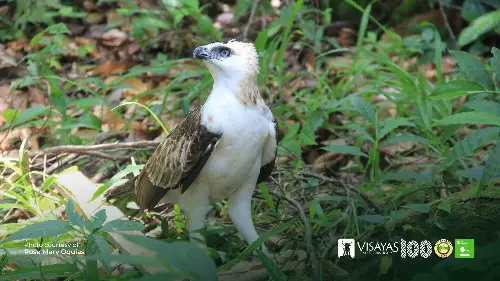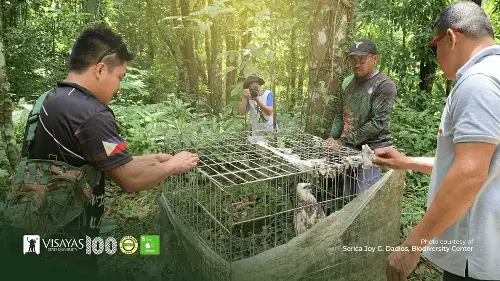
LEYTE, Philippines – Visayas State University (VSU,) in partnership with the City Environment and Natural Resources Office (CENRO) of Baybay City, released a native endangered species of eagle called Pinsker’s hawk-eagle back into the wild on August 8 — another achievement in line with the university’s goal in the conservation and protection of wildlife resources.
CENRO personnel with the Baybay city government brought the eagle for release to the Zonal Center for Biodiversity Conservation and Habitat Restoration (Biodiversity Center) of VSU.
The center is the perfect environment for the release not just because it promotes wildlife rescue as part of the university’s sustainable development goals but the area is also surrounded by native trees that are the home of wild animals.
Over 10 representatives witnessed the release, half of them from the Biodiversity Center led by Serica Joy Dadios, a faculty member of the Institute of Tropical Ecology & Environmental Management (ITEEM) and an affiliate of the Biodiversity Center.
However, the eagle remained in a certain area of the Center approximately two hours after the release. To facilitate the eagle’s readiness to fly, Biodiversity Center personnel decided to place it in a large, open cage until it could slowly adjust and gain the confidence to soar freely.

According to Dadios, this is the second time that the Biodiversity Center and CENRO-Baybay with the Baybay LGU released a Pinsker’s hawk-eagle in the university. This can guarantee that with continuous monitoring for protection and feeding, it will soon be comfortable in the area to take flight together with the other 13 confidently spotted unrecognized eagles wandering in the center from time to time.
While there is no tracker for monitoring the released birds, they are still certain that these birds survived. Using binoculars, they monitored them nesting in some of the native trees in the Center.
“The propagation of native species of trees through the rainforestation advocacy of VSU is helpful because everyone should be informed that the native kinds of trees are the natural habitat of our birds and wildlife. They will be present again in our area if we also restore our native trees,” Dadios said.
VSU is also home to many other wildlife species for both fauna and flora, like the Philippine flying lemur, the Samar hornbill, the Visayan miniature babbler, the Malabayabas tree, and Milan’s Dendrobium orchid. A 2022 article by Amaranth praised the presence of these rare species in the university as “essentially better than jewels, diamonds, and even gold.” This growing population of wildlife emphasizes VSU’s commitment to environmental conservation. – Rappler.com
This article is republished with permission from the Visayas State University.